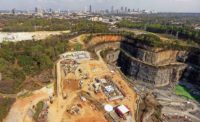
The recession is over, and many owners once again are being attracted to the benefits of alternative project delivery. Further, as legislative barriers are falling and public agencies are becoming more familiar with the process, alternative delivery is making inroads into markets that, previously, have not been receptive to straying beyond design-bid-build.
The upswing in alternative project delivery can be seen in the rankings of ENR's Top 100 Construction Management-at-Risk (CMR) Firms and Top 100 Design-Build (DB) Firms. The Top 100 CMR firms had a combined revenue from CMR of $103.98 billion in 2014, up 7.4% from the $96.84 billion reported by the group in 2013.
But what is striking in the numbers is that CMR revenue for the Top 100 dropped 9.5%, to $17.21 billion, from international projects in 2014. In the domestic market, CMR rose 11.5%, to $86.77 billion.
The DB list provides an even starker contrast between domestic and international project delivery: Overall, the Top 100 DB firms had a total revenue of $109.59 billion in 2014, up only 0.7% from 2013; revenue from domestic DB projects surged 13.7%, rising to $69.26 billion, in 2014. On the other hand, international DB revenue dropped 15.8% in 2014, thanks in part to a falloff in huge engineering-procurement-construction projects in the international mining, power and petroleum markets.
The growth of work in domestic alternative project delivery is in part a reflection of the overall growing construction market. However, many firms comment that alternate project delivery is getting increased attention from owners—especially in the public-sector markets, long bastions of traditional design-bid-build. "Throughout our civil sector, we are seeing more alternate delivery methods, such as design-build, CM-at-risk, CM-GC and public-private partnerships," says Shaun Yancey, president of PCL U.S.
How To Choose
"There are a lot of owners that have used alternative project delivery like design-build and have embraced it. But there are many more owners that are in the project delivery 101 stage and need help choosing a method," says Lisa Washington, DBIA's CEO. She says the free booklet, which is available on the DBIA website, provides the pluses and minuses of choosing design-bid-build, CMR, design-build or multiple primes.
DBIA also is in the process of developing sets of best practices for the federal, transportation and water and wastewater markets. "We published a set of universal best practices for design-build last year called 'Design Build Done Right' but now are taking comments and suggestions for more market-specific best practices," says Peter Kinsley, president of the government and public services group at Haskell and this year's DBIA chairman. He says these guidelines should be available later in the year.
The increasing familiarity among public agencies with collaborative approaches in construction is leading to rapid growth in the use of alternate project delivery in the public sector. "You need the enabling legislation for public agencies, but then you need a few success stories of agencies using design-build before it begins to take hold. So, it can take a while before design-build gains traction in a state," notes Kinsley,
Black & Veatch now is targeting the public-agency market, particularly water utilities, for alternative project delivery. "We are seeing a growing trend from owners to consider alternative forms of project delivery that drive a more collaborative process to plan, design and build critical infrastructure," says Mike Orth, senior vice president of Black & Veatch's water business.
Orth says that, as North American utilities have deep roots in traditional low-bid procurement processes, the trend will be slow to change. "But having a single point of responsibility to avoid confusion over design or construction responsibility is a growing point of emphasis by many owners," he says.
Transportation has been another area in which nontraditional approaches are being explored. Further, the squeeze on long-term public infrastructure funding has caused many public agencies to try new ways to fund and deliver projects. Public-private partnerships and the use of design-build-operate-maintain processes are becoming more widespread.
However, these methods are still in the early stages of development. "There seems to be an experiment with design-build-maintain going in a few states. While I like the idea and see it as an emerging market, there are a few kinks to be worked out, especially with regard to sureties for those long-term commitments," says Daniel J. Filer, vice president of business development, Ferrovial Agroman US Corp.





Post a comment to this article
Report Abusive Comment